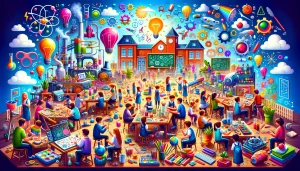In recent years, there has been a growing emphasis on STEAM education in schools and educational institutions worldwide. But what exactly is STEAM, and why is it so important? Let’s delve into the concept and explore its significance in shaping the future of learning.
What is STEAM Education?
STEAM stands for Science, Technology, Engineering, Arts, and Mathematics. Unlike traditional education models that compartmentalize these subjects, STEAM integrates them into a cohesive approach to learning. It emphasizes critical thinking, problem-solving, creativity, and collaboration—skills that are essential for success in the 21st century.
In STEAM education, students engage in hands-on, inquiry-based activities that encourage exploration and experimentation. They apply concepts from multiple disciplines to solve real-world problems, fostering a deeper understanding of how the world works and how they can make a meaningful impact.
Read Here: why is physical education important
Why is STEAM Education Important?

Cultivates Environmental Stewardship:
STEAM education instills a sense of environmental responsibility by encouraging students to explore solutions to pressing environmental challenges. Through interdisciplinary projects that integrate science, technology, engineering, arts, and mathematics, students gain an understanding of sustainability, conservation, and the impact of human activities on the environment.
By engaging in hands-on activities such as designing eco-friendly solutions, conducting environmental experiments, or creating artwork that raises awareness about environmental issues, students develop a deeper appreciation for the natural world and become advocates for environmental stewardship.
This holistic approach to learning not only equips students with the knowledge and skills needed to address environmental issues but also fosters a sense of personal responsibility and empowers them to make positive contributions to the planet.
Promotes Global Citizenship:
STEAM education prepares students to be active and engaged global citizens by fostering an understanding of interconnectedness and cultural diversity. Through collaborative projects that involve students from diverse backgrounds and perspectives, students gain insight into global issues such as climate change, poverty, and social justice.
By exploring these issues through a STEAM lens, students learn to appreciate the complexity of global challenges and develop empathy and respect for different cultures and perspectives.
Through cross-cultural exchanges, service-learning projects, and virtual collaborations with students from around the world, students develop the skills and attitudes needed to navigate an increasingly interconnected and interdependent world.
By promoting global awareness, empathy, and collaboration, STEAM education prepares students to become responsible and compassionate citizens who are capable of making positive contributions to a diverse and interconnected global community.
Advanced Technological Literacy:
In an increasingly technology-driven world, STEAM education equips students with the digital literacy skills needed to thrive in the digital age. Through hands-on activities that integrate technology into the learning process, students learn to use a variety of digital tools and platforms to solve problems, create multimedia projects, and communicate ideas effectively.
By exploring concepts such as coding, robotics, digital media, and computer programming, students develop the critical thinking, problem-solving, and computational skills needed to succeed in a technology-driven society.
STEAM education also promotes digital citizenship by teaching students about online safety, digital ethics, and responsible use of technology. By fostering technological literacy, STEAM education prepares students to navigate and contribute to a rapidly evolving digital landscape, empowering them to harness the power of technology for innovation, creativity, and social change.
Supports Career Exploration:
STEAM education exposes students to a wide range of career opportunities in STEM-related fields, inspiring them to explore and pursue careers aligned with their interests and passions.
Through hands-on activities, guest lectures, job shadowing experiences, and internships, students gain insight into various STEM careers and the skills and qualifications needed to succeed in these fields.
By engaging with professionals and industry experts, students learn about emerging trends, cutting-edge technologies, and potential career pathways in STEM disciplines such as engineering, computer science, biotechnology, and environmental science. STEAM education also promotes entrepreneurship and innovation by encouraging students to develop their own ideas, products, and projects and explore opportunities for starting their own businesses or pursuing entrepreneurial ventures.
By providing exposure to diverse career options and hands-on experiences in STEM fields, STEAM education empowers students to make informed decisions about their future career paths and prepares them for success in a rapidly evolving workforce.
Strengthens Civic Engagement:
STEAM education empowers students to become active and informed citizens by engaging them in community-based projects and civic initiatives that address local and global challenges. Through service-learning experiences, students apply their STEM knowledge and skills to real-world problems and make meaningful contributions to their communities.
By collaborating with community organizations, government agencies, and non-profit groups, students learn about the role of civic engagement in addressing social, environmental, and economic issues. Through projects that involve data analysis, community mapping, environmental monitoring, or urban planning, students develop a deeper understanding of the interconnectedness of social and environmental issues and the role of STEM in driving positive social change.
STEAM education also promotes environmental activism and social justice by encouraging students to advocate for policies and practices that promote sustainability, equity, and inclusivity. By fostering civic engagement and social responsibility, STEAM education prepares students to become active and empowered citizens who are capable of making meaningful contributions to their communities and the world.
Encourages Lifelong Learning:
STEAM education fosters a love for learning and a curiosity about the world that extends beyond the classroom. By providing students with opportunities to explore, experiment, and discover, STEAM education ignites a passion for lifelong learning and intellectual growth.
Through inquiry-based projects, hands-on experiments, and creative activities, students develop a growth mindset and a thirst for knowledge that drives them to seek out new experiences and pursue their interests outside of school. By nurturing a love for learning and a spirit of curiosity, STEAM education prepares students to adapt to a rapidly changing world and embrace new opportunities for growth and exploration throughout their lives.
Whether through independent research, self-directed projects, or continued education and training, STEAM education empowers students to become lifelong learners who are curious, creative, and committed to ongoing personal and professional development.
Challenges to Providing STEAM Education
Program Consistency:
Implementing STEM programs often faces challenges due to the lack of consistency within the concept itself. STEM has evolved into various iterations, each with its unique emphasis and priorities:
STEAM:
Integrating arts into STEM highlights creativity, exploration, and design. While not categorizing arts as a science, STEAM argues for their integral role in STEM subjects.
STEMC:
Adding computer science as a significant component prioritizes its importance. Advocates assert that as technology evolves, a deeper understanding of computer science becomes essential.
STREAM:
Building on STEAM, this program incorporates reading as a fundamental subject. It emphasizes that strong literacy skills are crucial for STEM success from an early age.
These variations emphasize essential skills and student success but may lead to prioritizing STEM subjects over others. Schools should ensure STEM programs don’t neglect other areas like arts and humanities.
Teacher Qualifications
Many schools encounter challenges with teacher certification when implementing STEM programs. Teachers often lack the necessary training or experience to teach complex STEM concepts, such as computer science and engineering.
Inadequate training not only affects lesson delivery but also impedes teachers’ ability to make real-world connections—a vital aspect of STEM education. Without familiarity with practical applications, teachers may struggle to relate STEM concepts to everyday life effectively.
To address this, schools should prioritize providing teachers with the necessary training and support for teaching complex STEM topics. Offering professional development opportunities like training sessions or attending STEM conferences can enhance teachers’ confidence and competence in delivering STEM education effectively.
National or State Standards
National or state standards ensure consistency in primary education across the country, but STEM programs lack comprehensive standards. While science and math curricula adhere to specific criteria and standardized tests, technology and engineering programs lack standardized benchmarks. This absence makes it challenging for schools and teachers to develop STEM curricula, especially without field experience or training.
Funding and Infrastructure
Funding and infrastructure present additional hurdles. Many school districts lack the resources to support comprehensive STEM programs due to budget constraints. While elementary and middle school programs can manage basic concepts, high school programs often require advanced technology to engage students and expand their knowledge.
However, acquiring expensive equipment and hiring qualified teachers strain budgets, leading to disparities in STEM education between affluent and low-income areas. Despite these challenges, schools can seek funding through various programs to support STEM initiatives and provide equal opportunities for all students.
Read Here: why classical education is bad
Crafting Dynamic STEM Programs: Tips for Educators

To effectively incorporate STEM into education and address its challenges, educators can follow these tips to create engaging and impactful programs:
Develop a Comprehensive Curriculum:
Crafting a thorough curriculum is essential for introducing students to diverse STEM subjects they may not encounter otherwise. Including a wide range of activities and lessons ensures that each student encounters topics that pique their interest, fostering curiosity and engagement.
Designate Dedicated STEM Spaces:
Establishing specific areas for STEM activities encourages ongoing exploration and excitement among students. Whether it’s a classroom corner stocked with STEM resources or a designated laboratory for experiments, providing dedicated spaces fosters a conducive environment for hands-on learning and inquiry.
Start Early:
Introducing STEM concepts to students as young as kindergarten and preschool age is crucial for instilling foundational skills and fostering a lifelong interest in STEM fields. Early exposure allows younger children to engage with STEM materials, explore the world around them, and develop critical thinking and problem-solving skills from an early age.
Read Here: how to become educator
Conclusion:
In conclusion, STEAM education is essential for preparing students for success in the 21st century. By integrating science, technology, engineering, arts, and mathematics into a cohesive approach to learning, STEAM education fosters innovation, addresses real-world problems, promotes critical thinking and problem-solving, prepares students for the future workforce, and encourages diversity and inclusion. As we continue to navigate the challenges and opportunities of the digital age, investing in STEAM education is more important than ever to ensure that all students have the skills and knowledge needed to thrive in a rapidly changing world.
